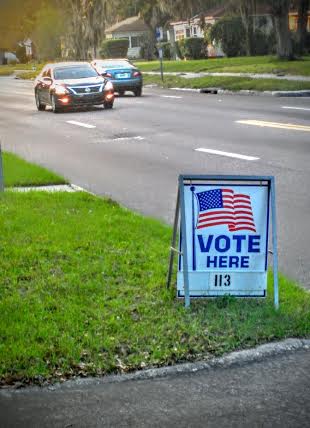BY KALIE MCCAUSLAND
NNB Reporter
Between voting on four candidates running for both District 5 and District 7 and four referendum questions the 2015 St. Petersburg general election could mean significant change in Midtown.
Steve Kornell, the incumbent, won District 5 and will serve a third and final term on City Council. The native St. Petersburg resident has been involved in the Midtown community for many years.
“I didn’t get involved because I want to run for office,” said Kornell earlier in the campaign. “I was involved, and that’s why I ran for office.”
He plans to continue to focus on boosting education and establish a youth employment program where students who participate can get college credit.
Kornell didn’t win by a landslide, however, his opponent Philip Garrett lost by about 3,000 votes (or 11 percentage points). Garrett has lived in Midtown for almost 25 years. He started a grassroots campaign in order to make a difference where he lives and as an example for his children. Unlike the $45,000 of campaign contributions that Kornell raised, Garrett spent only around $1,400 and relied more on knocking on doors to spread his message.
In District 7, Lisa Wheeler-Brown defeated Winthrop “Will” Newton by 15 percent (roughly 4,000 votes). She strives to reduce crime, improve education and create more jobs in the area.
Newton doesn’t lose hope though. Although he is upset that he didn’t win, he will continue to, “work on behalf of the men and women whoput on uniforms and protect us.” He attributes his loss to a time factor. Where his opponent had started her campaign in January, Newton didn’t get his start until July. His brother Wengay “Newt” Newton is the current City Council member for District 7.
Residents also voted on four referendums whic dealt with protections to sea grass beds, district boundaries, residency restrictions for elected officials and how to tally council member votes. They all were approved.
The first referendum offers protections to some seagrass beds that have developed in Tampa Bay in the past few years. It allows the City Council to impose restrictions on these lands without holding a referendum. The council will still be required to hold a public hearing. It passed with an 85 percent majority.
The second referendum addresses redrawing the voting precinct lines to more natural borders. This means that they would be redrawn along train tracks and major roads, eliminating the jigsaw shape of many of the current districts. The changes would not take effect until a redistricting commission is established, which usually corresponds with when the U.S. Census is taken. The referendum passed with a 62 percent majority.
A candidate for mayor or city council does not need to remain a resident of the district in which they are running after winning election. The third referendum question removed that oversight. Previously they were only required to have lived in the district for 12 months to run for office, and were free to move after elected. It also ensures that the mayor must reside in the city throughout their term.
“I’m surprised that this wasn’t a requirement to begin with, this should have been a requirement a long time ago,” said Carla Bristol, who serves on the board of the Dr. Carter G. Woodson Museum and owns the art studio Gallerie909. “I am 100 percent in favor of it being a requirement – if you’re going to serve the people then you’re going to need to live among the people.”
The referendum passed with a 94 percent majority.
The fourth referendum question would allow the electronic voting system within the City Council to be the primary voting system allowed without verbal recitation of the city clerk. This referendum passed with a 72 percent majority.
Low voter turnout was the biggest trend at the polling booths. At the 113th precinct located inside the Christ Gospel Church, only about 50 voters came out to cast their ballots. Though this number seems low, it is twice what the turnout was there last election.
However, at another precinct, only found one voter by noon at the Child’s Park Recreational Center. The voter was very enthusiastic, but still the only one.
The empty booths may not be entirely about voter disengagement. The majority of votes came by absentee ballots. With mail-in ballots, a voter can vote at their own time starting a month before Election Day. Roughly 80 percent of the votes cast in this election were by mail-in.
“People growing up and voting now will never see the inside of a voting booth,” said John Carassas, a county judge who serves in the Canvassing Review Board, which certifies the election. “They’re missing out on that special experience,” Carassas said.
Clarence Ford, Lorien Mattiacci, Zenena Moguel, Samanthat Pritzlaff, Choya Randolph, Carly Romano, Rim Shuman, Indhira Suero Acosta, Brigitte Toulon, Eric Vaughan, and Danielle Von Dreele contributed to this story.
